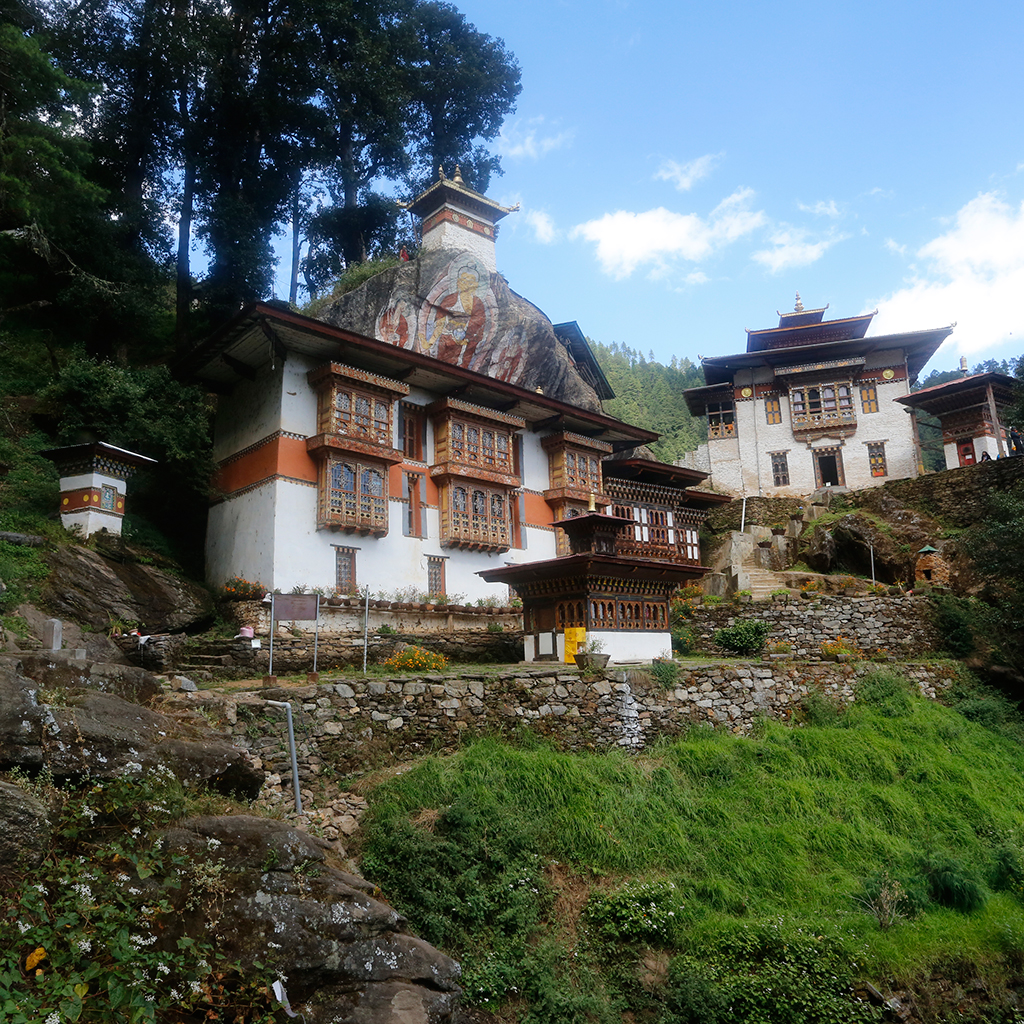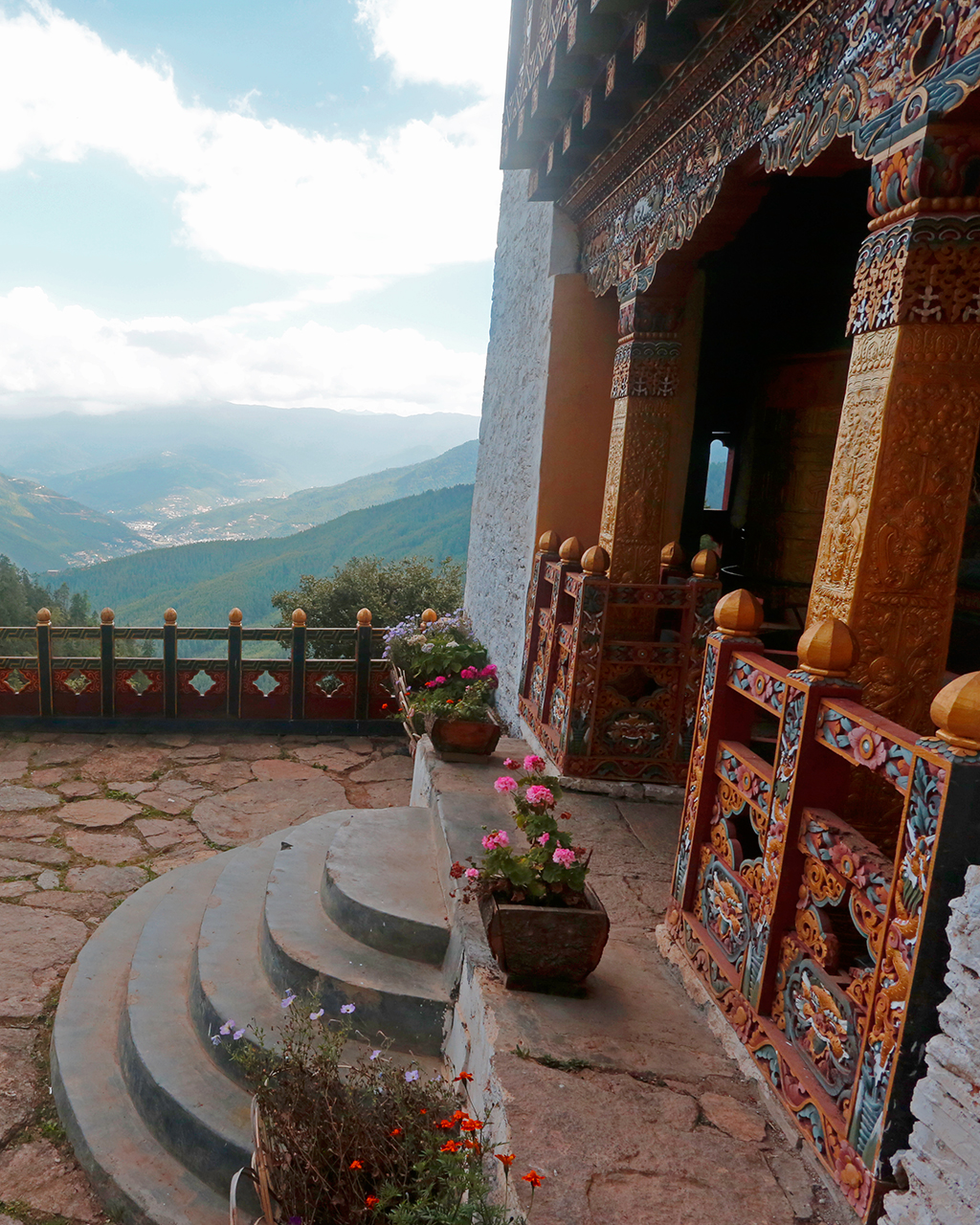Dodey Drak Monastery

It is interesting to observe that formal spaces that assert power might be awe inspiring but it is the informal and organic ones that free your mind. This is especially true in adolescence and young adulthood, when one needs spaces that encourage curiosity and allow one to dream about the future. The Dodey Drak monastery, hidden in one of the many valleys around Thimphu, holds such a promise. This was Ugyen’s next stop after his tenure at PunakhaPunakha (Dzongkha: སྤུ་ན་ཁ་) is the administrative centre of Punakha dzongkhag, one of the 20 districts of Bhutan. Punakha was the capital of Bhutan and the seat of government until 1955, when the capital was moved to Thimphu. https://en.wikipedia.org/wiki/Punakha.
The path as we travel from northern Thimphu climbs gradually, from 7500 feet to almost 10000 feet, reaching the top of a steep cliff. Mixed conifers give way to dense temperate rainforests, and clouds hang low over clusters of human habitation. A mud path leads downward from the top, and the monastery reveals itself around a bend. A viewing pavilion marks our destination, a vantage point from where to survey the lush green slopes and windows peeping from between trees. Higher up in the mountains, we spot a few hermitages around caves, isolated and hugging the cliffs. A short distance down is the formal gateway to Dodey Drak, home to 200 monks and their teachers.

Dodey Drak was established in the 18th century by the 13th Je KhenpoThe Je Khenpo (Tibetan: རྗེ་མཁན་པོ་, Wylie: Rje Mkhan-po; “The Chief Abbot of the Central Monastic Body of Bhutan”), formerly called the Dharma Raj by orientalists, is the title given to the senior religious hierarch of Bhutan. as a monastery but fell to ruins after. Revived in 1986 by the 3rd king, it is one of the many shedrasShedra is a Tibetan word (བཤད་གྲྭ, bshad grwa) meaning “place of teaching” but specifically refers to the educational program in Tibetan Buddhist monasteries and nunneries. It is usually attended by monks and nuns between their early teen years and early twenties.https://en.wikipedia.org/wiki/Shedra established in recent times. Dotted with sculptures of the earth goddess which arise from small waterbodies, a sense of informality infects the space. Numerous student projects, in landscape and sculpture, give it the air of being a space for exploration and expression. The sounds of the dungchenThe Tibetan horn (dungchen; Tibetan: ) is a long trumpet or horn used in Tibetan Buddhist and Mongolian buddhist ceremonies. It is the most widely used instrument in Tibetan Buddhist culture. It is often played in pairs or multiples, and the sound is compared to the singing of elephants. Tsultrim Allione described the sound: It is a long, deep, whirring, haunting wail that takes you out somewhere beyond the highest Himalaya peaks and at… being practiced by the students permeates the air as one ambles along the stone pathway.
Ugyen recalls his four years here as being one of the best experiences of his monastic study. At Dodeydra, he was expected to manage his routine and self study, imposing rigour of a different kind. Instruction here had a more philosophical bent when compared to the rigid bounds he had known before. In his time, the monks worked through the week and spent Saturday afternoons at the new football field a little way up the mountain. From here, they would climb down to spend a Sunday in Thimphu, picking up supplies and interacting with friends and family.

The three temples that are the heart of Dodeydra are part of the original development. Growing out from the cliff, they overlook the dense valley and roaring river below. The spaces for instruction and living are staggered on the face of the mountain, affording each one a view of the valley below. The Buddha statue which watches over Thimphu town is clearly visible in the distance – a landmark which orients and reminds the residents of the world outside. Steep and narrow stone paths connect the buildings, pausing at rickety wooden decks and benches. As we look out from our vantage point, we watch sujaSuja or Butter tea is a staple drink of the people in the Himalayan countries such as Nepal, India (in particular Sikkim and Ladakh), Tibet and Bhutan. Read More. being served to the monks as they stream out after a class. They colour the paths with their deep red robes, their chatter filling the air on the steep hillside.

While the structures all carry the charm of traditional bhutanese architecture, it is the plan’s response to the powerful terrain that is truly remarkable. It makes Dodey drak a place where the immense beauty of nature absorbs you and makes you want to explore the wonder of the unknown.
Vignettes





